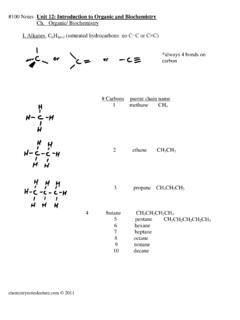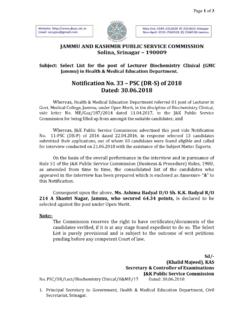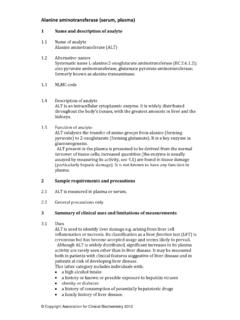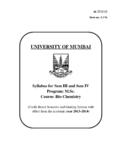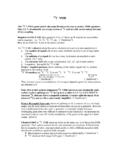Transcription of National Metabolic Biochemistry Network Guidelines for the ...
1 - 1 - National Metabolic Biochemistry Network Guidelines for the investigation of hypoglycaemia in infants and children Aim To provide guidance on the biochemical investigation of hypoglycaemia in infants and children in the non-specialist setting, particularly in relation to the investigation of inherited defects of intermediary metabolism. Introduction Hypoglycaemia is usually defined as a blood glucose of less than mmol/L. POCT (point of care testing) devices, are at their least accurate in the low part of their range and it is important to confirm any suspected hypoglycaemia by a accurate laboratory based measurement of glucose. Treatment should not be delayed by waiting for the laboratory glucose but, if possible, appropriate samples should be collected before giving glucose to allow identification of the underlying cause.
2 When to suspect hypoglycaemia? There is usually compelling clinical evidence of symptomatic hypoglycaemia. The early features are associated with the adrenergic response. Neuroglycopaenic symptoms follow and become more predominant as the hypoglycaemia persists. Adrenergic symptoms include pallor, anxiety, sweating, tachypnoea tremor, weakness, nausea and vomiting. Neuroglycopenic symptoms include jitteriness, hunger, abdominal pain, apnoea, headache, confusion, feeding problems, visual disturbances and convulsions and coma. The predominance and severity of symptoms depend on the age of the patient and the rapidity of onset and duration of the hypoglycaemia. The investigation and treatment of symptomatic hypoglycaemia is a clinical emergency as delayed treatment leads to a risk of permanent brain damage.
3 - 2 - Causes of hypoglycaemia Causes of hypoglycaemia may be split into several main groups: Endocrine Hyperinsulinism Adrenal insufficiency Hypopituitarism Growth Hormone Deficiency Hypothyroidism Metabolic Disorders of Fatty Acid Oxidation and Carnitine Transport Disorders of Carbohydrate Metabolism Disorders of Organic Acid Metabolism Disorders of Gluconeogenesis Other Causes Neonatal complications: prematurity, birth asphyxia, congenital heart defects, infants of diabetic mother secondary hyperinsulinism Drug Related: insulin, alcohol, aspirin, chemotherapy Liver and multi-organ failure Sepsis, Gastroenteritis Idopathic ketotic hypoglycaemia The most common cause for hypoglycaemia in children after the neonatal period is idiopathic ketotic hypoglycaemia. This is usually precipitated by an often relatively mild illness. Taking a good clinical history may help in directing the investigations.
4 Age and presentation are important clinical clues. Any history of drug or alcohol including inhaled steroids needs to be noted. The main points to note include the time since the last meal and whether there is hepatomegaly, liver dysfunction, short stature, hyper pigmentation or small genitalia. High glucose requirements (>10 mg/kg/min) indicate hyperinsulinism (Table one causes of hypoglycaemia). Neonatal hypoglycaemia Biochemical hypoglycaemia is common in the neonatal period (<72 hours after birth) prior to establishing feeds. In these infants the full biochemical screen is not usually required unless the hypoglycaemia does not respond to a feed or if the blood glucose remains persistently or recurrently low. It is important to remember that in neonate hypoglycaemia is commonly secondary to septicaemia, severe systemic illness, intrauterine growth retardation or maternal diabetes.
5 - 3 - Investigations of hypoglycaemia 1. Before giving glucose draw blood for following analytes: Analyte Minimum volume and common preservative Glucose 3 OH butyrate Free Fatty Acids Lactate 2ml Fluoride Oxalate* Insulin Cortisol Growth Hormone Amino Acids 3ml Lithium Heparin* Acyl carnitines 1ml Lithium Heparin or 2-3 blood spots collected on a Guthrie Card* Save any residual plasma from these samples as this may be used for further tests if indicated *check with local laboratory for sample types and minimum volumes In some hospitals it may be appropriate to assemble all the necessary bottles and prepared specimen request forms for ease of use by medical staff. The hypoglycaemic pack should ensure that all the necessary investigations are undertaken. DO NOT DELAY CORRECTING HYPOGLYCAEMIA IF THE BLOOD IS DIFFICULT TO OBTAIN.
6 2. First line investigations (samples can be taken after glucose has been given) Blood gases Liver function tests Urea Electrolytes Ammonia Save any residual plasma for further tests 3. Collect first passed urine sample for - Ketones Reducing substances Organic acids Toxicology screen (only required if there is a clinical suspicion of factitious or accidental illness). - 4 - Interpretation of tests The results of these investigations should be evaluated in the context of the clinical symptoms and a differential diagnosis established. See table two for some examples of interpretation. Further specialist investigations may be indicated these tests are usually undertaken by specialist Metabolic or endocrine laboratories. For details of specimen requirements by specialist Metabolic laboratories see Metabolic assay directory.
7 Prolonged fast tests On occasion it may be necessary to provoke hypoglycaemia by undertaking a prolonged fasting test. This is potentially a very dangerous procedure and should only be carried out under close medical supervision and after discussion with a Metabolic specialist. It is essential that a Metabolic screen (urine organic acids and plasma/blood spot acylcarnitines) is carried out prior to any fast and normal results have been obtained. - 5 - Table two Examples of interpretation of the biochemical results (please note this is not an exhaustive list of interpretation but an aid to basic Biochemistry / Metabolic tests in investigating hypoglycaemia. General Biochemistry General Biochemistry is unlikely to give a definitive cause for the hypoglycaemia but some clues into a Metabolic cause can be derived from them, some examples include: Low sodium with raised potassium will be seen in many endocrine disorders associated with low glucocorticoids.)
8 Abnormal liver function tests are seen in liver failure and in numerous inherited Metabolic defects ( the glycogen storage diseases). A raised lactate may also indicate a glycogen storage disease or defect of energy metabolism. An unexplained acidosis with an increased anion gap may indicate a defect of organic acid metabolism, particularly if the lactate concentration is insufficient to explain the finding. Many organic acidaemias are associated with hyperammonaemia. Intermediary metabolites: Free fatty acids 3-hydroxybutyrate Glucose Lactate Sample must be taken at time of hypoglycaemia to allow accurate interpretation. 1. Low FFA and 3-hydroxybutyrate concentrations at time of hypoglycaemia suggest hyperinsulinism 2. FFA/3-hydroxybutyrate ratio 1 indicates appropriate lipolytic and ketogenic response to hypoglycaemia 3.
9 FFA/3-hydroxybutyrate ratio >2 suggests a FA oxidation defect Note that neonates may have a poor Metabolic response to hypoglycaemia and patients on chemotherapy/tpn or with liver disease may produce an unusual pattern of intermediary metabolites in response to hypoglycaemia. See appendix one for further interpretation. - 6 - Endocrine tests Insulin, cortisol and growth hormone Detectable insulin in a hypoglycaemic sample indicates hyperinsulinism. Low cortisol indicates either hypoadrenalism or hypopituitarism further tests, such as dynamic function tests, are required. Low growth hormone may indicate hypopituitarism or isolated growth hormone deficiency Amino acids Raised ketogenic (branched chain) and gluconeogenic amino acids are seen in ketotic hypoglycaemia.
10 Low plasma amino acids are noted in anabolic patients or patients with poor protein reserves. Acylcarnitines Raised ketogenic (branched chain) and gluconeogenic amino acids are seen in ketotic hypoglycaemia. Low plasma amino acids are noted in anabolic patients or patients with poor protein reserves. Specific acylcarnitine species will be raised if there is a fatty acid oxidation defect or organic acidaemia causing the hypoglycaemia. A specific pattern of acylcarnitines will be observed as a response to a ketogenic and lipolytic response to a Metabolic stress. Organic acids Ketone bodies and dicarboxylic acids are seen as part of the normal response to fasting hypoglycaemia. Specific organic acids will usually be present in a crisis sample from patients with fatty acid oxidation disorders or organic acidaemias.


